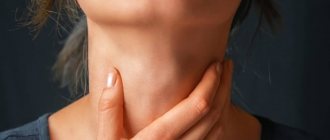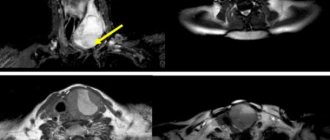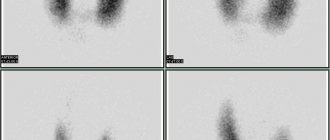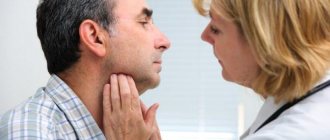Determination of thyroid-stimulating hormone levels is used as a basic test to assess thyroid function in both hypothyroidism and hyperthyroidism. Hypothyroidism
(decreased production of thyroid hormones), characterized by a slowdown in the basic functions of the body: the patient, as a rule, complains of weakness, depression, fatigue, low blood pressure, hair loss, etc. A severe form of hypothyroidism is called myxedema and can lead to heart failure, convulsive syndrome and coma.
Hyperthyroidism
(excessive production of thyroid hormones) is characterized by an acceleration of body functions: patients, on the contrary, complain of rapid heartbeat, restlessness, anxiety, insomnia, and weight loss. The most severe form of hyperthyroidism is thyrotoxic crisis, a life-threatening condition.
Changes in TSH synthesis lead to
- Brain injuries, massive blood loss
and hypothalamic-pituitary diseases, primarily tumors in the hypothalamic-pituitary zone. - Pituitary tumors
(mainly adenomas of the anterior or glandular lobe) cause an increase in the production of pituitary hormones. They, in turn, affect the activity of other endocrine glands (thyroid gland, ovaries, adrenal glands, etc.) and contribute to the development of hypothyroidism, diabetes mellitus and diabetes insipidus, hypothalamic-pituitary insufficiency and endocrine infertility. - Diseases of other endocrine glands
, particularly tumors or adrenal insufficiency, can also suppress or stimulate TSH production. - Hypothalamic-pituitary insufficiency
, which occurs when the pituitary gland and hypothalamic nuclei are damaged due to an infectious process, toxic effects, autoimmune (in which the immune system attacks the body tissues) and vascular diseases, as well as removal of the pituitary gland, is accompanied by a change in TSH levels and requires its control. - Hemorrhage
(hemorrhagic stroke) in the pituitary gland causes a sharp drop in TSH levels, but with this pathology, symptoms of cerebral bleeding (impaired consciousness, severe diffuse headache, photophobia, nausea, repeated vomiting) come to the fore. - In women, TSH levels change during complicated childbirth
or
abortion
, as well as during
pregnancy
. A TSH test is mandatory when screening pregnant women in the first trimester.
Features of taking levothyroxine sodium
The content of the article
Synthetically produced levothyroxine sodium (L-T4), taken orally, is the standard treatment for both primary and secondary hypothyroidism, regardless of its cause, at various stages of life, such as pregnancy, the neonatal period, childhood, in all age groups, also in older people with concomitant diseases.
Dry thyroid preparations, triiodothyronine, or combination thyroxine with triiodothyronine are not recommended by several scientific societies, including the ETA (European Thyroid Association), ATA (American Thyroid Association), and AACE (American Association of Clinical Endocrinologists).
Absorption of thyroxine - why you need to comply with the conditions for taking the drug
Thyroxine preparations are absorbed in the upper gastrointestinal tract, of which 21% - in the duodenum, 45% - in the upper small intestine and 34% - in the lower small intestine, which leads to a maximum increase in serum thyroxine concentration after 2 -4 hours.
The half-life of the hormone is 7 days, so a stable level of thyroxine is achieved with daily administration. The degree of absorption of the tablet drug depends on the pH of the stomach. Fasting increases the rate of absorption, while eating and some medications, as well as malabsorption syndromes, worsen it.
Gastric pH
When taken on an empty stomach, 70-80% of the administered dose is absorbed. It is believed that the use of gelatin capsules and drops can provide 100% absorption, since in this form it is not dependent on the pH of gastric juice. Isolated reports indicate improved absorption of thyroxine with concomitant administration of 500 mg vitamin C by an unknown mechanism, possibly dependent on increased solubility of the tablet in the stomach. The bioavailability of thyroxine preparations, especially generics, varies.
Why may TSH decrease?
Low TSH hormone indicates malfunctions in the functioning of the pituitary-thyroid system. Causes of insufficient production of thyrotropin include:
- TSH-independent thyrotoxicosis;
- mental disorders;
- toxic goiter;
- hypothalamic-pituitary insufficiency;
- autoimmune thyroiditis;
- Plummer's disease;
- cachexia.
If thyroid-stimulating hormone is low and T3 and T4 are higher than normal, hyperthyroidism is diagnosed. Low values of TSH and iodine-containing hormones indicate hypopituitarism, a pathology of the pituitary gland in which the production of thyrotropin stops. Factors that provoke a decrease in TSH include:
- low-quality tumors in the thyroid gland;
- prolonged stress;
- long-term use of medications with thyroid hormones;
- abuse of strict diets.
Low thyrotropin in pregnant women is a physiological condition.
If there are no signs of ophthalmopathy (eye damage), treatment is not carried out. Organic damage to the pituitary gland, an important part of the brain, leads to insufficient TSH synthesis. Possible causes of low thyrotropin include trauma, inflammation of the meninges due to meningitis, and encephalitis. Hormonal imbalance occurs in tumor diseases of the brain - astrocytomas, gliomas.
Goal of treatment
The goal of thyroxine treatment is to achieve clinical and biochemical euthyroidism, controlled by achieving the desired TSH concentration, and to avoid overdose. Treatment will prevent the progression of hypothyroidism with the risk of hypometabolic coma (myxedema coma), improve quality of life, reduce the risk of cardiovascular complications, menstrual irregularities and improve fertility. Treatment of a pregnant woman prevents obstetric complications and ensures the correct development of the child’s central nervous system. Treatment of children prevents neurological and somatic complications.
Insufficient thyroxine dosage results in persistent symptoms of hypothyroidism, increased cholesterol and LDL cholesterol, cognitive impairment, increased diastolic blood pressure, weight gain, increased risk of coronary heart disease, atrial fibrillation, heart failure, and cardiovascular mortality.
Increased diastolic blood pressure
Overdose of thyroxine leads to symptoms of hyperthyroidism, cardiovascular diseases, including atrial fibrillation and osteoporosis with an increased risk of fractures.
- The benefits of treating overt hypothyroidism are achieved at any age.
- The benefits of treating subclinical hypothyroidism depend on age and are most pronounced in young people during their childbearing years.
- Treatment after age 60 does not improve quality of life or reduce mortality from cardiovascular diseases.
- In children, the treatment of subclinical hypothyroidism remains controversial, with most guidelines stating that treatment of cases with TSH concentrations of 5-10 mU/L is unnecessary and does not improve the child's psychomotor and somatic parameters. However, this is necessary in case of TSH concentration > 10 mU/L.
Pregnant women also require treatment in the subclinical phase of hypothyroidism.
Consequences for the body
If thyroid-stimulating hormone decreases in women due to dysfunction of the hypothalamus or pituitary gland, there are no life-threatening complications. The worst consequences occur when the thyroid gland malfunctions or increases thyroid hormones:
- heart failure;
- protrusion of eyeballs;
- osteoporosis;
- amenorrhea (lack of menstruation);
- dysmenorrhea (painful menstruation);
- infertility;
- thyroid diabetes;
- anorexia;
- apathy;
- cachexia.
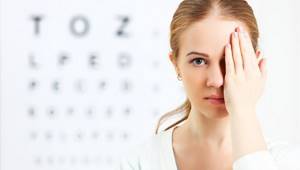
The most dangerous complication with low TSH and high T4 is thyrotoxic crisis. In women, it manifests itself as delirium, acute heart failure, fever, and loss of consciousness. For approximately 30% of patients it ends in death.
A low TSH level is an alarming symptom, which in most cases indicates an overactive thyroid gland. Excessive secretion of thyroid hormones is fraught with dangerous diseases. Therefore, at the first signs of illness, you need to be examined by an endocrinologist.
Principles of treatment with thyroxine
Treatment with thyroxine can be started on the basis of the full dose received since the start of treatment, or by titrating the dose.
- In newborns and pregnant women, the full dose is usually prescribed, and this may also apply to young people with short-term hypothyroidism.
- For patients over 50-60 years of age, gradual administration of the drug is recommended.
- In neonates, 10-15 mcg/kg/day is administered initially without risk of adverse effects on bone development.
The coexistence of adrenal insufficiency requires first the supply of steroid replacement and then thyroid hormones.
The dose of thyroxine required for recovery depends on a number of factors:
- Causes of hypothyroidism - higher dose in case of atyremia compared to patients who still have their own thyroid gland;
- Severity of hypothyroidism - higher dose for overt than for subclinical hypothyroidism;
- Age – lower dose in older age due to lower T4 metabolism;
- Gender – lower dose in men than in premenopausal women;
- Body weight is a good parameter to evaluate the initial dose (start of therapy), for young people, full replacement dose: 1.6-1.8 mcg/kg/day, suppression dose: 2-2.5 mcg/kg/day;
- Lean body mass is the best parameter to estimate the required dose;
- Deiodinase activity decreases in elderly, obese people, in chronic and acute diseases, increases in tumors containing deiodinase, for example, hemangioma;
- Deiodinase polymorphism – leads to the need to increase the dose;
- Pregnancy - increase the dose by 50%, which corresponds to approximately 2-2.4 mcg / kg / day;
- Eating food and medications.
It should be understood that thyroxine intake does not accurately mimic physiology, and TSH is not an ideal marker of tissue euthyroidism. This is especially true for patients who have had a total thyroidectomy, an organ that is a source of both thyroxine (T4) and triiodothyronine (T3).
The thyroid gland produces thyroxine and triiodothyronine in a molar ratio of 15: 1. We do not have complex drugs that mimic physiological secretion. Available T3 drugs with a half-life of 1 day are recommended for patients with differentiated thyroid cancer for a short time after discontinuation of thyroxine to provide a shorter break in thyroid hormone deficiency and in the treatment of hypometabolic coma.
Polymorphisms in deiodinase type 2 genes or thyroid hormone transporters may reduce the availability of metabolically active triiodothyronine in tissues. Molecular tests detect these abnormalities, but they are not currently recommended in clinical practice due to limited availability and the possibility of other factors influencing intracellular thyroid hormone concentrations.
However, it should be noted that a certain group of patients will benefit from the combination of thyroxine + triiodothyronine. The complex formulation must maintain an appropriate molar ratio of T4 to T3, and the triiodothyronine preparation must have a long half-life, with a slowly releasing active substance, without the risk of rapid changes in serum triiodothyronine concentration.
According to many societies, including the AACE, ATA, and ETA, combination therapy is currently contraindicated in pregnant women and in patients with cardiac arrhythmia and heart failure. It is acceptable for patients with persistent symptoms of hypothyroidism despite biochemical euthyroidism to improve quality of life.
This type of therapy can be prescribed in exceptional cases by qualified specialists who closely monitor the treatment to identify and prevent side effects.
Tissue biomarkers dependent on the action of thyroid hormones, such as cholesterol, creatine kinase, SHBG, can also indicate metabolic control. It should be remembered that these parameters are not sensitive and specific enough, so they cannot be recommended in everyday clinical practice.
The standard is daily morning administration of thyroxine on an empty stomach 30-60 minutes before breakfast, an alternative option is daily administration within 3-4 hours after dinner. In uncooperative patients, successful results are also achieved after administering the required full weekly dose once a week or divided into two doses administered twice a week.
Daily morning administration of thyroxine on an empty stomach
Weekly administration is not recommended for patients with coronary heart disease due to a transient supraphysiological increase in the concentration of thyroid hormones within 1-2 days after administration.
If absorption is impaired, weekly intramuscular administration is possible at a dose reduced to 70% of the oral dose. When reducing the dose parenterally, the principle of incomplete absorption of the drug from the gastrointestinal tract is taken into account.
What are the health risks of low TSH?
Low thyrotropin due to hypothalamic-pituitary insufficiency does not pose a serious health hazard. But a decrease in TSH due to an overactive thyroid gland is fraught with:
- myocardial dystrophy;
- anorexia;
- vegetative-vascular dystonia;
- thyroid diabetes;
- protrusion of eyeballs;
- adrenal insufficiency;
- blindness;
- osteoporosis;
- immunodeficiency.
Hormonal imbalance in a pregnant woman is sometimes caused by gestosis, which is manifested by increased blood pressure and convulsions. The pathology poses a danger to both the mother and the fetus.

If thyroid-stimulating hormone is below normal and its level ranges from 0.05 mU/l to 0.1 mU/l, you need to take thyreostatics. Ignoring the problem is dangerous due to thyrotoxic crisis and death.
Treatment monitoring
Monitoring of thyroxine treatment for primary hypothyroidism is possible by assessing TSH concentrations, and in patients with secondary hypothyroidism by testing fT4 concentrations. Only in children with congenital primary hypothyroidism should the T4 concentration also be checked, which should be in the upper normal range or in the upper half of normal. This state should be achieved 2-4 weeks after the start of treatment, and then TSH and fT4 levels should be monitored every 1-2 months during the first year of life.
Typically, TSH is assessed 4-8 weeks after starting treatment and every 6-12 months thereafter. During pregnancy, monthly TSH testing is required.
It is estimated that 10% of properly treated patients do not achieve satisfactory improvement in quality of life despite metabolic control.
Reference TSH values depending on age and therapeutic indications are shown in Table 1.
Table 1. Desired TSH levels in patients receiving thyroxine
| Age/clinical condition | TSH concentration (mU/l) |
| Planned pregnancy | Lower normal range <1.2 |
| Pregnancy 1st trimester | <2,5 |
| Pregnancy II, III trimesters | <2.5 or <3.0 |
| Children with congenital hypothyroidism | <5.0, optimal 0.5-2.0 with fT4 concentration in the upper normal range at 1 year of age |
| Young people | 1-2,5 |
| Average age | 1-3,0 |
| ≤ 65 | > 4,5 |
| 60-70 | > 6.0 |
| 70-80 | > 7,0-8,0 |
| Central hypothyroidism | fT4 in the upper half of normal |
| Thyroid cancer | According to the principles of stratification of thyroid cancer |
Complexes with this research
Advanced anti-aging diagnostics in postmenopause Advanced monitoring of age-related changes during postmenopause 16,450 RUR Composition
Fitness control of sports nutrition Assessment of liver function, hormone levels and metabolism when taking sports nutrition 1,970 RUR Composition
Stress complex Assessment of the body's condition during stress RUR 2,070 Composition
IN OTHER COMPLEXES
- Fitness monitoring RUB 3,380
- Causes of hair loss RUB 1,350
- Female hormones. Menopause 920 R
- Preventive check-up RUB 4,080
- Male anti-aging diagnostics RUB 5,840
Elevated TSH levels in patients receiving thyroxine
Maintaining a high TSH level despite treatment with thyroxine may be due to:
- Lack of cooperation, skipping pills every day (affects 30-80% of patients with confirmed elevated TSH levels during treatment).
- Incorrect dose or route of administration.
- Malabsorption due to celiac disease, lactose intolerance, atrophic gastritis, Helicobacter pylori infection, intestinal infections including Giardia, small intestinal bacterial overgrowth, liver diseases such as cirrhosis, congestive liver failure, pancreatic insufficiency, intestinal surgery leading to shortening of the intestines, taking medications that interfere with the absorption of thyroxine, such as calcium, iron, proton pump inhibitors, H2 inhibitors.
- Increased turnover or excretion of thyroxine.
- The presence of p/bodies that interfere with the determination of TSH, causing a falsely high concentration of TSH.
- Coexistence of resistance to thyroid hormones.
- Coexistence of adrenal insufficiency.
Assessment of thyroxine absorption from the gastrointestinal tract can be performed using a test consisting of a single 1000 mcg T4 administration in the fasted state and an fT4 test at 2, 4 and 6 hours. If peak concentrations are expected after 2 hours and should be above the upper limit of normal, a value below 20 pmol/L should be assessed as malabsorption - malabsorption or apparent malabsorption - pseudomalabsorption.
You can add paracetamol to the test, a drug whose absorption mechanism differs from that of thyroxine. It consists of simultaneous administration of 1000 mcg of thyroxine and 1000 mg of paracetamol with assessment of the concentration of fT4 and paracetamol in the blood both before the study and at the 1st, 2nd, 3rd and 4th hours of the test.
The main pathways of paracetamol biotransformation
Evidence of taking paracetamol is the presence of the drug in the blood serum, and evidence of taking and absorbing thyroxine is an increase in fT4 concentration.
Symptoms of low TSH
Symptoms are determined by the characteristics and causes of endocrine pathology. If TSH is low due to an overactive thyroid gland, this will be indicated by:
- excessive sweating;
- feeling of sand in the eyes;
- high blood pressure;
- weight loss;
- fast speech;
- causeless anxiety;
- aggressiveness;
- dyspnea;
- feeling of heartbeat;
- feeling of heat.
If the TSH concentration is at the lower limit of normal, subclinical hyperthyroidism is diagnosed. The disease is asymptomatic, since TSH does not fall below 0.4 mU/l, and T3 and T4 levels do not exceed the upper threshold of normal.
In hypothalamic-pituitary insufficiency, TSH is low, so the secretory activity of the gland is not stimulated. Because of this, signs of hypothyroidism occur:
- hair loss;
- pathological dry skin;
- weak pulse;
- decrease in temperature;
- apathy;
- chilliness;
- drowsiness;
- fast fatiguability;
- weight gain;
- swelling of the face, etc.
If hypo- and hyperthyroidism manifests itself, you should contact an endocrinologist. Delayed treatment is dangerous for severe complications.
Wilson syndrome
Dr. Dennis Wilson from Florida suggested the use of triiodothyronine in patients with clinical symptoms of hypothyroidism such as fatigue, water retention, weight gain, dry skin and brittle nails, depression, memory loss, muscle and joint pain, hypoglycemia, constipation, and bowel syndrome. irritability and chronic fatigue, body temperature 36.6 °C (97.8 °F) or lower with normal TSH and thyroid hormone levels.
He attributed this to tissue deficiency of triiodothyronine and called the condition Wilson's syndrome. Due to the potential risk of adverse effects of such procedures on the bones and heart, as well as the possibility of delaying diagnosis of another cause of the above-mentioned diseases, the ATA issued a statement in 2005 that there is no substantial basis for diagnosing Wilson syndrome.
Reasons for low TSH
A decrease in hormone levels is observed:
- with diffuse toxic goiter;
- thyrotoxic adenoma;
- postpartum necrosis of the pituitary gland;
- latent thyrotoxicosis;
- pituitary injuries;
- nervous breakdown or starvation due to diet;
- attempts to independently regulate the amount of T4 and the subsequent development of thyrotoxicosis.
A drop in TSH levels can be observed in pregnant women with hypothyroidism.
Changes in the direction of decreasing hormone levels occur when using certain medications. The list includes anabolic steroids, glucocorticosteroids, cytostatics, antihypertensive medications and other drugs.
Treatment with thyroid hormones is always a difficult issue
There is much evidence that TSH is not an ideal marker of metabolic control, and in some patients treatment with thyroxine alone is not sufficient. This especially applies to patients after complete thyroidectomy or with polymorphism of deiodinase activity.
Combining T4 with T3 in the appropriate molar ratio mimics physiology by taking into account the need for triiodothyronine in a long-acting, slow-release formulation. But there is no consensus on the treatment of subclinical hypothyroidism in children.
There are doubts about the treatment of low T3 syndrome with triiodothyronine drugs. The role of thyroxine in the treatment of nodular goiter is considered in the light of data showing a relationship between elevated TSH concentrations and the occurrence of thyroid cancer.
A good option for patients with thyroid cancer may be the use of thyroid hormone analogues, which can suppress TSH without affecting the cardiovascular system and bones. Similarly, thyroid hormone analogues with selective hepatic receptor agonist activity, such as eprotir, can be used to treat hypercholesterolemia without the risk of adverse cardiovascular and bone effects.
When is a test for TSH hormone levels prescribed?
The level of thyrotropin in the blood is measured in μU per liter or honey per liter. An analysis for the concentration of this hormone is prescribed by a therapist or endocrinologist in the absence of a menstrual cycle, prolonged depression, suspected insufficiency of thyroid hormones or goiter of the thyroid gland, undergoing a course of hormonal therapy, female and male infertility, lack of potency, cardiovascular pathologies, delayed intellectual and sexual development in children, muscle damage and low body temperature, alopecia or baldness.
However, you should know that there are many different factors that influence the concentration of this hormone in human blood.
For example, the highest TSH level is achieved at night, and the lowest in the evening - from five to seven o'clock. If the patient is awake at night, the production of thyrotropin is significantly reduced.
During pregnancy and breastfeeding, the level of this hormone decreases significantly, and this is absolutely normal. Taking various medications can also affect the concentration of TSH in the body.
conclusions
Although a healthy thyroid gland is a source of both thyroxine and triiodothyronine, triiodothyronine preparations or combination thyroxine and triiodothyronine are not recommended. Triiodothyronine is recommended only for patients with differentiated thyroid cancer, a short-term course after discontinuation of thyroxine and in the treatment of hypometabolic coma.
The goal of treatment with thyroxine is to achieve clinical and biochemical euthyroidism. TSH is a convenient parameter for diagnosis and treatment monitoring, with the exception of conditions such as central hypothyroidism, medications (glucocorticoids, dopamine), the presence of antibodies to TSH, early pregnancy, adrenal insufficiency (possibly increased TSH).
The dose of the drug depends on a number of factors, including the cause and severity of hypothyroidism, age, weight and comorbidities. The standard is to take the drug daily on an empty stomach 30-60 minutes before breakfast; an alternative is to take it daily 3-4 hours after dinner.
Successful results are also achieved when the full weekly dose is administered once a week or divided into two doses administered twice a week. In cases of malabsorption, intramuscular administration is possible weekly. Daily intravenous administration may be used in patients with severe hypothyroidism who cannot be treated orally.
Assessing the absorption of thyroxine from the gastrointestinal tract can be done using a test consisting of a single administration of 1000 mcg T4 in the fasted state and testing fT4 after 2, 4 and 6 hours. The study differentiates malabsorption from pseudomalabsorption. Drugs from different companies are not considered equivalent, so changing drugs after the dose has been established should be avoided.
Causes of increased thyroid-stimulating hormone
Changes in the direction of increasing TSH levels may be associated with:
- with a benign neoplasm in the pituitary gland – thyrotropinoma;
- adenoma in the anterior pituitary gland;
- syndrome of resistance to hormonal elements of the thyroid gland;
- irregular production of thyrotropin;
- juvenile hypothyroidism, other formations in the pituitary gland;
- subacute thyroiditis;
- chronic pathologies, including mental illnesses;
- removal of the gallbladder, lead intoxication;
- excessive physical activity, hemodialysis procedures;
- preeclampsia.
The element may increase during therapy with certain medications:
- anticonvulsant action - during treatment with Benserazide, Phenytoin;
- beta blockers - Atenolol, Metaprolol;
- Morphine, Prednisone, Rimphapicin.
A similar deviation occurs during therapeutic procedures using iodides and Calcitonin.
Sources
- Jonklaas J, Bianco AC, Bauer AJ et al: Hypothyroidism treatment guidelines prepared by the American Thyroid Association Task Force on Thyroid Hormone Replacement. Thyroid 2014;
- Jubiz V, Ramirez V. Effect of vitamin C on the absorption of levothyroxine in patients with hypothyroidism and gastritis. J Clin Endocrinol Metab 2014;
- Hayes M.T.: Parenteral administration of thyroxine. Thyroid 2007;
- Kempke J: Treatment of thyroxine malabsorption. J Clin Endocrinol Metab 2015;
- Biondi B, Wartofsky L: Thyroid hormone treatment. Endocrine Reviews 2015;
- Anderson L: Isolated thyroxine malabsorption treated with intramuscular thyroxine injections. Am J Med Sci 2009;
- Tonjes A: Impaired enteral absorption of levothyroxine in hypothyroidism refractory to oral therapy after thyroid ablation for papillary thyroid cancer: a case report and kinetic studies. Thyroid 2006.
ONLINE REGISTRATION at the DIANA clinic
You can sign up by calling the toll-free phone number 8-800-707-15-60 or filling out the contact form. In this case, we will contact you ourselves.
If you find an error, please select a piece of text and press Ctrl+Enter



